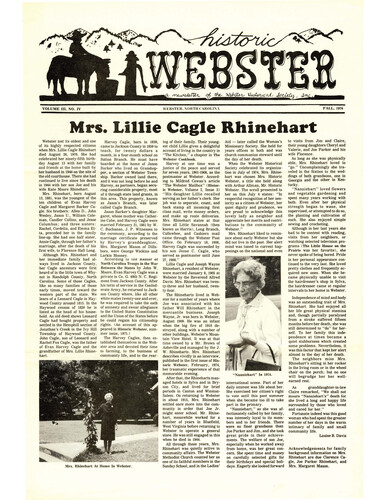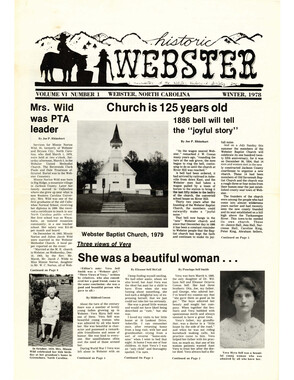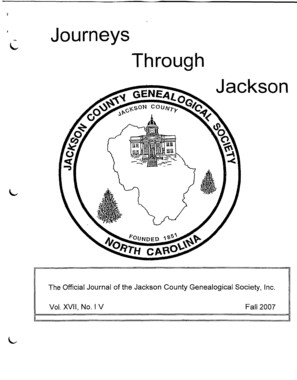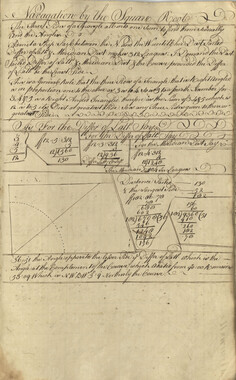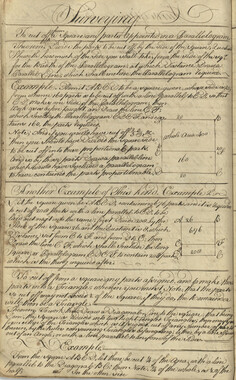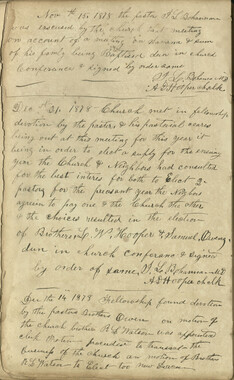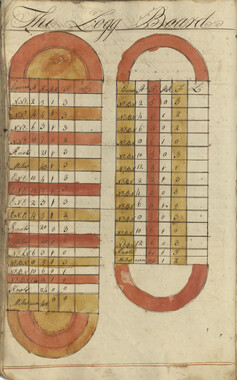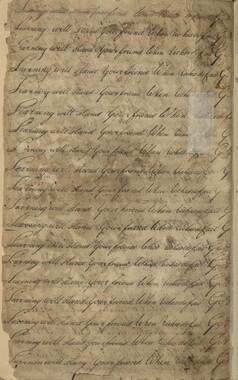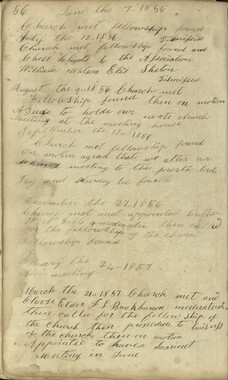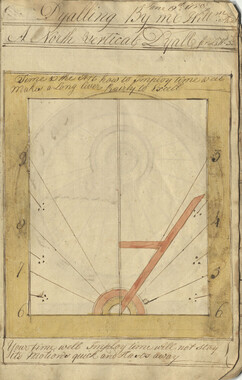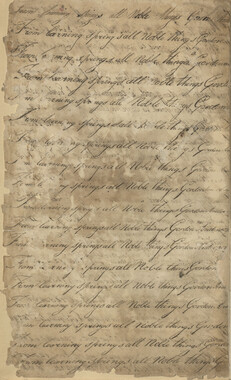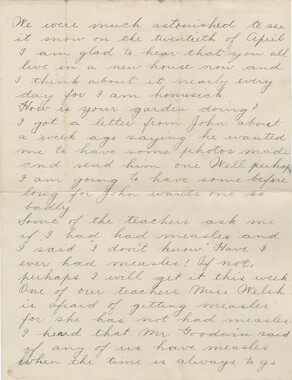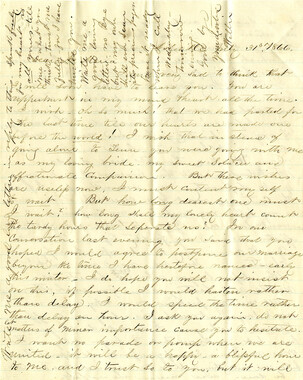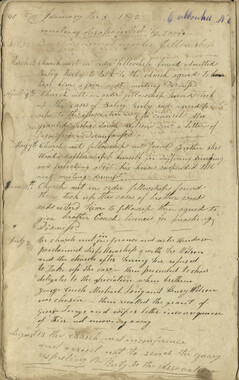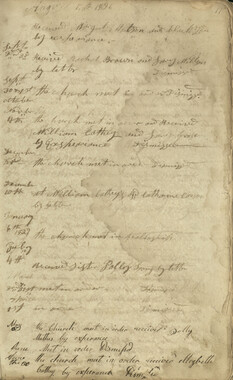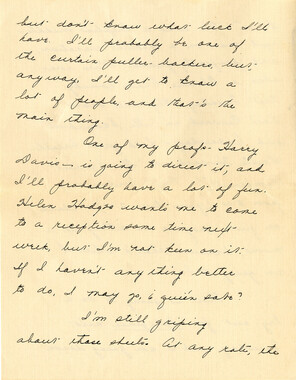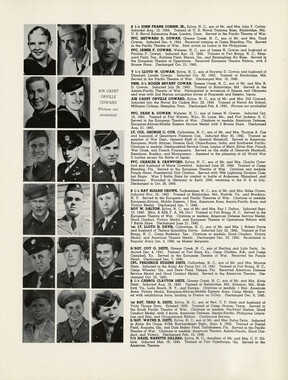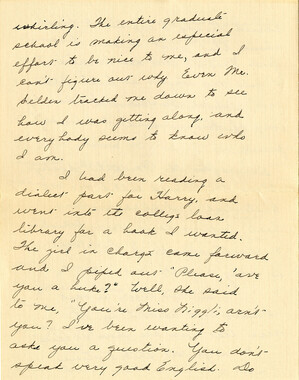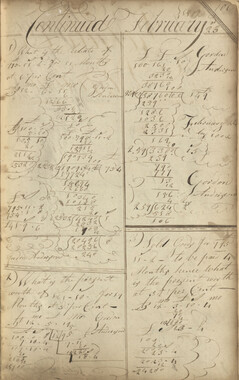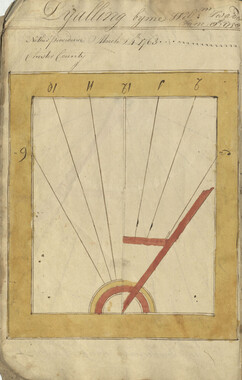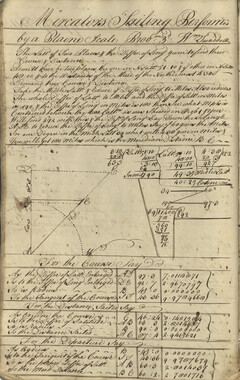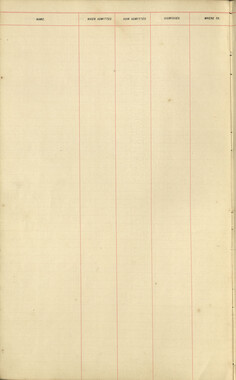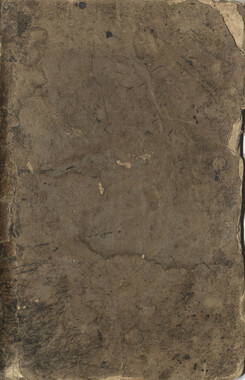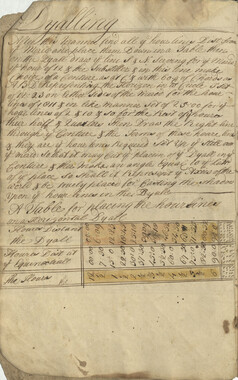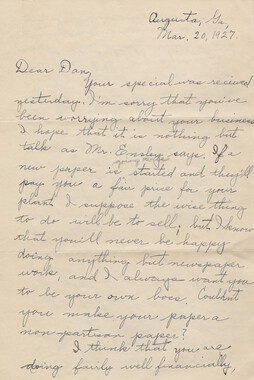Western Carolina University (21)
View all
- Canton Champion Fibre Company (2308)
- Cherokee Traditions (291)
- Civil War in Southern Appalachia (165)
- Craft Revival (1942)
- George Masa Collection (137)
- Great Smoky Mountains - A Park for America (3182)
- Highlights from Western Carolina University (422)
- Horace Kephart (998)
- Journeys Through Jackson (159)
- LGBTQIA+ Archive of Jackson County (90)
- Oral Histories of Western North Carolina (318)
- Picturing Appalachia (6617)
- Stories of Mountain Folk (413)
- Travel Western North Carolina (153)
- Western Carolina University Fine Art Museum Vitreograph Collection (129)
- Western Carolina University Herbarium (92)
- Western Carolina University: Making Memories (738)
- Western Carolina University Publications (2491)
- Western Carolina University Restricted Electronic Theses and Dissertations (146)
- Western North Carolina Regional Maps (71)
- World War II in Southern Appalachia (131)
University of North Carolina Asheville (6)
View all
- Allanstand Cottage Industries (62)
- Appalachian National Park Association (53)
- Bennett, Kelly, 1890-1974 (1463)
- Berry, Walter (76)
- Brasstown Carvers (40)
- Carver, George Washington, 1864?-1943 (26)
- Cathey, Joseph, 1803-1874 (1)
- Champion Fibre Company (233)
- Champion Paper and Fibre Company (297)
- Cherokee Indian Fair Association (16)
- Cherokee Language Program (22)
- Crowe, Amanda (40)
- Edmonston, Thomas Benton, 1842-1907 (7)
- Ensley, A. L. (Abraham Lincoln), 1865-1948 (275)
- Fromer, Irving Rhodes, 1913-1994 (70)
- George Butz (BFS 1907) (46)
- Goodrich, Frances Louisa (120)
- Grant, George Alexander, 1891-1964 (96)
- Heard, Marian Gladys (60)
- Kephart, Calvin, 1883-1969 (15)
- Kephart, Horace, 1862-1931 (313)
- Kephart, Laura, 1862-1954 (91)
- Laney, Gideon Thomas, 1889-1976 (439)
- Masa, George, 1881-1933 (61)
- McElhinney, William Julian, 1896-1953 (44)
- Niggli, Josephina, 1910-1983 (10)
- North Carolina Park Commission (105)
- Osborne, Kezia Stradley (9)
- Owens, Samuel Robert, 1918-1995 (11)
- Penland Weavers and Potters (36)
- Roberts, Vivienne (15)
- Roth, Albert, 1890-1974 (142)
- Schenck, Carl Alwin, 1868-1955 (1)
- Sherrill's Photography Studio (2565)
- Southern Highland Handicraft Guild (127)
- Southern Highlanders, Inc. (71)
- Stalcup, Jesse Bryson (46)
- Stearns, I. K. (213)
- Thompson, James Edward, 1880-1976 (226)
- United States. Indian Arts and Crafts Board (130)
- USFS (683)
- Vance, Zebulon Baird, 1830-1894 (1)
- Weaver, Zebulon, 1872-1948 (58)
- Western Carolina College (230)
- Western Carolina Teachers College (282)
- Western Carolina University (2008)
- Western Carolina University. Mountain Heritage Center (18)
- Whitman, Walt, 1819-1892 (10)
- Wilburn, Hiram Coleman, 1880-1967 (73)
- Williams, Isadora (3)
- Cain, Doreyl Ammons (0)
- Crittenden, Lorraine (0)
- Rhodes, Judy (0)
- Smith, Edward Clark (0)
- Appalachian Region, Southern (3032)
- Asheville (N.C.) (1945)
- Avery County (N.C.) (26)
- Blount County (Tenn.) (200)
- Buncombe County (N.C.) (1680)
- Cherokee County (N.C.) (283)
- Clay County (N.C.) (556)
- Graham County (N.C.) (247)
- Great Smoky Mountains National Park (N.C. and Tenn.) (535)
- Haywood County (N.C.) (3573)
- Henderson County (N.C.) (70)
- Jackson County (N.C.) (4926)
- Knox County (Tenn.) (61)
- Knoxville (Tenn.) (21)
- Lake Santeetlah (N.C.) (14)
- Macon County (N.C.) (421)
- Madison County (N.C.) (216)
- McDowell County (N.C.) (39)
- Mitchell County (N.C.) (135)
- Polk County (N.C.) (35)
- Qualla Boundary (982)
- Rutherford County (N.C.) (78)
- Swain County (N.C.) (2187)
- Transylvania County (N.C.) (270)
- Watauga County (N.C.) (12)
- Waynesville (N.C.) (86)
- Yancey County (N.C.) (72)
- Aerial Photographs (3)
- Aerial Views (60)
- Albums (books) (4)
- Articles (1)
- Artifacts (object Genre) (228)
- Bibliographies (1)
- Biography (general Genre) (2)
- Cards (information Artifacts) (38)
- Clippings (information Artifacts) (193)
- Copybooks (instructional Materials) (3)
- Crafts (art Genres) (622)
- Depictions (visual Works) (21)
- Design Drawings (1)
- Digital Moving Image Formats (2)
- Drawings (visual Works) (185)
- Envelopes (115)
- Exhibitions (events) (1)
- Facsimiles (reproductions) (1)
- Fiction (general Genre) (4)
- Financial Records (12)
- Fliers (printed Matter) (67)
- Glass Plate Negatives (381)
- Guidebooks (2)
- Internegatives (10)
- Interviews (823)
- Land Surveys (102)
- Letters (correspondence) (1070)
- Manuscripts (documents) (618)
- Maps (documents) (177)
- Memorandums (25)
- Minutes (administrative Records) (59)
- Negatives (photographs) (6192)
- Newsletters (1290)
- Newspapers (2)
- Notebooks (8)
- Occupation Currency (1)
- Paintings (visual Works) (1)
- Pen And Ink Drawings (1)
- Periodicals (194)
- Personal Narratives (10)
- Photographs (12977)
- Plans (maps) (1)
- Poetry (6)
- Portraits (4573)
- Postcards (329)
- Programs (documents) (181)
- Publications (documents) (2444)
- Questionnaires (65)
- Relief Prints (26)
- Sayings (literary Genre) (1)
- Scrapbooks (282)
- Sheet Music (2)
- Slides (photographs) (402)
- Songs (musical Compositions) (2)
- Sound Recordings (802)
- Specimens (92)
- Speeches (documents) (18)
- Tintypes (photographs) (8)
- Transcripts (329)
- Text Messages (0)
- A.L. Ensley Collection (275)
- Appalachian Industrial School Records (7)
- Appalachian National Park Association Records (336)
- Axley-Meroney Collection (2)
- Bayard Wootten Photograph Collection (20)
- Bethel Rural Community Organization Collection (7)
- Blumer Collection (5)
- C.W. Slagle Collection (20)
- Canton Area Historical Museum (2110)
- Carlos C. Campbell Collection (564)
- Cataloochee History Project (64)
- Cherokee Studies Collection (4)
- Daisy Dame Photograph Album (5)
- Daniel Boone VI Collection (1)
- Doris Ulmann Photograph Collection (112)
- Elizabeth H. Lasley Collection (1)
- Elizabeth Woolworth Szold Fleharty Collection (4)
- Frank Fry Collection (95)
- George Masa Collection (173)
- Gideon Laney Collection (452)
- Hazel Scarborough Collection (2)
- Hiram C. Wilburn Papers (28)
- Historic Photographs Collection (236)
- Horace Kephart Collection (861)
- Humbard Collection (33)
- Hunter and Weaver Families Collection (1)
- I. D. Blumenthal Collection (4)
- Isadora Williams Collection (4)
- Jesse Bryson Stalcup Collection (47)
- Jim Thompson Collection (224)
- John B. Battle Collection (7)
- John C. Campbell Folk School Records (80)
- John Parris Collection (6)
- Judaculla Rock project (2)
- Kelly Bennett Collection (1482)
- Love Family Papers (11)
- Major Wiley Parris Civil War Letters (3)
- Map Collection (12)
- McFee-Misemer Civil War Letters (34)
- Mountain Heritage Center Collection (4)
- Norburn - Robertson - Thomson Families Collection (44)
- Pauline Hood Collection (7)
- Pre-Guild Collection (2)
- Qualla Arts and Crafts Mutual Collection (12)
- R.A. Romanes Collection (681)
- Rosser H. Taylor Collection (1)
- Samuel Robert Owens Collection (94)
- Sara Madison Collection (144)
- Sherrill Studio Photo Collection (2558)
- Smoky Mountains Hiking Club Collection (616)
- Stories of Mountain Folk - Radio Programs (374)
- The Reporter, Western Carolina University (510)
- Venoy and Elizabeth Reed Collection (16)
- WCU Gender and Sexuality Oral History Project (36)
- WCU Mountain Heritage Center Oral Histories (25)
- WCU Oral History Collection - Mountain People, Mountain Lives (71)
- WCU Students Newspapers Collection (1923)
- Western North Carolina Tomorrow Black Oral History Project (69)
- William Williams Stringfield Collection (2)
- Zebulon Weaver Collection (109)
- African Americans (390)
- Appalachian Trail (35)
- Artisans (521)
- Cherokee art (84)
- Cherokee artists -- North Carolina (10)
- Cherokee language (21)
- Cherokee pottery (101)
- Cherokee women (208)
- Church buildings (190)
- Civilian Conservation Corps (U.S.) (114)
- College student newspapers and periodicals (2012)
- Dams (115)
- Dance (1023)
- Education (222)
- Floods (63)
- Folk music (1015)
- Forced removal, 1813-1903 (2)
- Forest conservation (220)
- Forests and forestry (1198)
- Gender nonconformity (4)
- Great Smoky Mountains National Park (N.C. and Tenn.) (181)
- Hunting (47)
- Landscape photography (25)
- Logging (122)
- Maps (83)
- Mines and mineral resources (9)
- North Carolina -- Maps (18)
- Paper industry (38)
- Postcards (255)
- Pottery (135)
- Railroad trains (72)
- Rural electrification -- North Carolina, Western (3)
- School integration -- Southern States (2)
- Segregation -- North Carolina, Western (5)
- Slavery (5)
- Sports (452)
- Storytelling (243)
- Waterfalls -- Great Smoky Mountains (N.C. and Tenn.) (66)
- Weaving -- Appalachian Region, Southern (280)
- Wood-carving -- Appalachian Region, Southern (328)
- World War, 1939-1945 (174)
Historic Webster Vol. 3 No. 4
-
Historic Webster is a newsletter of the Webster Historical Society, Inc., created at the Society’s founding in 1974. The publication helped to serve the Society's mission of collecting and preserving the history of Webster, North Carolina. Webster, established in 1851, was the original county seat for Jackson County.
-
-
WEBSTEK. MJKTH l'AK()LJ!\ ,\ FALL, 1976 Mrs. Lillie Cagle Rhinehart Webster lost its oldest and one of its highly respected citizens when Mrs. Lillie Cagle Rhinehart died August 26, 1976. She had celebrated her ninety-fifth birthday. August 13 with her family and friends at the home built by her husband in 1940 on the site of the old courthouse. There she had continued to live since his death in 1944 with her son Joe and his wife Kate Moore Rhinehart. Mrs. Rhinehart, born August 13, 1881, was the youngest of lhe ten children of Evan Harvey Cagle and Margaret Barker Cagle. Six brothers: Allen D., John Wesley, Jason U. , William Coleman, Candler Collins, and Jesse Columbus; and three sisters: Rachel, Cordelia, and Emma Etta, preceded her in the family line-up. She had one half sister, Annie Cagle, through her father's marriage, after the death of his first wife, to Florence Hall Long. Although Mrs. Rhinehart and her immediate family had always lived in Jackson County , her Cagle ancestors were first heard of in the little town of Whynot in Randolph County, North Carolina. Some of those Cagles, like so many families of those early times, moved toward !he western part of the state. We Jearn of a Leonard Cagle in Haywood County around 1815. 1n the Haywood census of 1820 he is listed as the head of his household. An old deed shows Leonard Cagle had bought property and settled in the Hemphill section of Jonathan 's Creek in the Ivy Hill Township of Haywood County. John Cagle, son of Leonard and Rachel Fox Cagle, was the father of Evan Harvey Cagle and !he grandfalher of Mrs. Lillie Rhinehart. Harvey Cagle, born in 1839, came to Jackson County in 1859 to teach , for twenty dollars a month , in a four-month school on Sutton Branch. He must have boarded at the home of Jason Barker who lived on Grasshopper, a section of Webster Township. Barker owned land there, and it was not long before he and Harvey , as partners , began securing considerable property, most of it through state land grants, in this area. This property, known as Jason 's Branch, was later called Cagle Branch. Jason Barker's daughter Margaret, whose mother was Catherine Cabe, and Harvey Cagle were married February 21, 1861 by W. C. Buchanan, J . P. Witnesses to the ceremony, according to the marriage certificate preserved by Harvey's granddaughter , Mrs. Margaret Mason of Dillsboro, were George Watkins and Larkin Mooney. Accoramg ro me ttoster ol North Carolina Troops in the War Between the States by John W. Moore, Evan Harvey Cagle was a private in Co. G. 69th N. C. Regiment from Jackson County. After his term of service in the Confederate Army, he returned to Jackson County where, like all other white males twenty-one and over, he was required to take the oath of amnesty and swear allegiance to the United States Constitution and the Union of the States before he could regain his citizenship rights. (An account of this appeared in Historic Webster, summer issue, 1975.) The Harvey Cagles, then established themselves in the Webster area and devoted their time to farming, to the business of community life, and to the rear- Mrs. Rhinehart At Home In Webster. ing of their family. Their youngest child Lillie gives a delightful account of living in the country in "The Kitchen ," a chapter in The Webster Cookbook. Harvey at one time was a justice of the peace and served for seven years, 1901-1908, as the postmaster at Webster. According to Mildred Cowan's article "The Webster Mailbox" (Historic Webster, Volume I, Issue 3) " His daughter Lillie recalled serving as her father's clerk. Her job was to separate, count, and back stamp all incoming first class mail, write money orders, and make up route deliveries. Mrs. Rhinehart states at that time all Little Savannah (then known as Harris), Long Branch , Cullowhee , and Cashiers mail came through the Webster Post Office. On February 18, 1908, Harvey Cagle was succeeded by his son Jesse C. Cagle, who served as postmaster until June 27, 1908." Lillie Cagle and Joseph Wayne Rhinehart, a resident of Webster, were married January 8, 1905 at Webster by the Reverend Alfred Davis. Mrs. Rhinehart was twenty- three and her husband, twenty- four. The Rhineharts Jived in Webster for a number of years where Joe was associated with his father Will Rhinehart in the mercantile business. Joseph Wayne, Jr. was born in Webster, August 1909. He was an infant when the big fire of 1910 destroyed, along with a number of other buildings, Webster's Mountain View Hotel. It was at that time owned by a Mr. Brown of Asheville and managed by the J . W. Rhineharts. Mrs. Rhinehart describes vividly in an interview , published in the first issue of Historic Webster. February, 1974, her traumatic experience of that memorable evening. After that, the Rhineharts managed hotels in Sylva and in Bryson City, and lived for brief periods in Canton and WinstonSalem. On returning to Webster in about 1915, Mrs. Rhinehart settled once more into the community in order that Joe Jr. might enter school. Mr. Rhinehart, meanwhile worked for a number of years in Bluefield, West Virginia before returning to Webster to operate a general store. He was still engaged in this when he died in 1944. All through those years, Mrs. Rhinehart was quietly active in community affairs. The Webster Methodist Church counted her as one of its faithful members in !he Sunday School, and in the Ladies' Aid - later called the Woman's Missionary Society. She held for years offices in both and was church communion steward until !he day of her death. When the Webster Historical Society celebrated its organization in July of 1974, Mrs. Rhinehart was chosen Mrs. Historic Webster, a title she held along with Arlhur Allman, Mr. Historic Webster. The scroll presented to her on this July 4 states: "In respectful recognition of her seniority as a citizen of Webster, her quiet dignity and prudence, we are proud to acknowledge this lovely lady as neighbor and appreciate her merits and contributions to the community of Webster." Mrs. Rhinehart liked to reminisce about early Webster but she did not live in !he past. Her alert mind was tuned to current happenings on the national and even "Nanniehart" In 1974. international scene. Part of her daily interest was life about her. She exercised her citizen's right to vote until this past summer when she became too ill to take part in !he primary. "Nanniehart," as she was affectionately called by her family, was intensely Joyal to its members and to her friends. There were no finer grandsons than Joe Parker and Jim, and she took great pride in their achievements. The welfare of son Joe, especially when he worked away from home, was her great concern. She spent time and money on carefullY. selected gifts for !heir birthdays and special holidays. Eagerly she looked forward to visits from Jim and Cl~ire, their young daughters Cheryl and Valerie, and Joe Parker and his wife Florence. As long as she was physically able, Mrs. Rhinehart loved to "go." Uncomplainingly she traveled in the Sixties to !he weddings of both grandsons, one in Georgia and the other in Kentucky. "Nanniehart" loved flowers and vegetable gardening and spent many_ years working with both. Even . after her physical strength began to wane, she supervised, or attempted to do so, the planting and cultivation of such. She also enjoyed simple sewing and crocheting. Although in her last years she had to be content with reading, visits from her neighbors, or watching selected television programs (The Little House on the Prairie was her favorite), she never spoke of being bored. Pride in her personal appearance continued to the very last. She loved pretty clothes and frequently acquired new ones. When she became physically unable to visit the hairdresser's shop in Sylva, the hairdr.esser came at regular intervals to her home in Webster. Independence of mind and body was an outstanding trait of Mrs. Rhinehart. She had enjoyed all her life great physical stamina and, though partially paralyzed from a stroke suffered fifteen months before her death, she was still determined to "do" for herself. To her family this independence at times became a quiet stubborness which created some problems. Nevertheless, it was this factor that kept her alert almost to the day of her death. The neighbors miss Mrs. Rhinehart's sitting in her rocker in the living room or in the wheel chair on the porch; but no one will begrudge her her wellearned rest. As granddaughter-in-law Claire remarked, "We shall not mourn "Nanniehart's" death for she lived a long and happy life surrounded by those who loved and cared for her.'' Fortunate indeed was !his good woman who had spent !he greater number of her days in !he warm intimacy of family and small community life. Louise B. Davis Acknowledgements for family background information on Mrs. Rhinehart are due Clarence Cagle, Joe Parker Rhinehart, and Mrs. Margaret Mason. Page 2 HISTORIC WEBSTER, Fall, 1976 This article about her grandfather, Captain James Wharey Terrell, was written many years ago by Annie Lizzie Terrell (now Mrs. Carl Hoyle of Bryson City) only daughter of Joel Keener Terrell and Laura Viola Cooper Terrell . The date of writing was approximately 1929 during the time Annie was a student at Western Carolina Teachers' College. She submitted it in an essay contest which was being held on the campus at that time. Information for the article was supplied by her parents and by her cousin, William Ernest Bird, Dean of WCTC, and also a grandson of Captain Terrell. that every drop of his blood descended to him through Revolutionary soldiers. At the age of three years he moved with his parents to Rutherfordton, where, until the age of fifteen , he had the advantage of an academy until he had a fair start in the common school branches. This was practically all he was able to go to school. He was considered in that day and time, a well educated man. His education , however, did not stop with this. He enjoyed literature and had a love and appreciation for the finer literary productions, which even the so-called educated man did not have. In April 1846, he came to Bethel The s ubject of this sketch , in Haywood County, to his GrandJames Wharey Terrell, was born father Kilpatrick's and began to on the French Broad River in learn the trade of tanner. He Rutherford County, North Caro- spent three years learning the lina, December 31, 1829. He was trade, but in the meantime spent born in the house built by his his spare moments in reading great grandfather, Thomas Wha- and studying books, in which he rey, while Thomas was a paroled made cons iderable improveprisoner in the Revolutionary ment. War. James W. Terrell was the Six years of his life, from the son of James Orville Terrell. His age of sixteen to twenty-two, in grandfather was Joel Terrell of which he attended school, taught Richmond, Virginia , who was school, and worked at intervals in married , in 1799, to Martha the lanyard were the happiest Williams, daughter of John Wil- years of his life. This happiness Iiams , also a Revolutionary War was probably due to the fact that soldier who followed Washington he was intimately associated from Massachusetts to York with books. The time spent in Town. His great-grandmother on study was not wasted. It was to his father 's side was a Miss prove a stepping stone for the Adams, a relative of John Ad- work which he later carried on. ams. His mother was Ermina R. In January , 1852, J. W. Terrell Kilpatrick and her mother was came to Quallatown , where he Jane Wharey, daughter of Thorn- and Colonel William H. Thomas, as Wharey who was also a then in the State Senate, became Revolutionary War soldier. His partners in the tanning business. great grandfather, Andrew Kil- .. After the Civil War, he was assopatrick was a Revolutionary ciated with Colonel Thomas at soldier and fought under Morgan Qualla in a general merchandise at Cowpens. His grandfather, store. He remained there for Joel Terrell , enlisted under Col- some time. He was then appointone! Lynch of Virginia in 1780 at ed Director of the Western Divisixteen years of age. He was sion of the Western North Carowounded in the battle of Guilford. !ina Railroad Company, signed Captain J. W. Terrell could boast by Secretary of State, H. J. Captain Terrell In His Early Years. Picture from the archives of Hunter Library, WCU. Menninger and Tod R. Caldwell, October 5, 1871. This certificate is now in the possession of his grandson Professor W. E. Bird, Dean of Western Carolina Teach· ers College. After this appointment Captain Terrell went to Alabama where he took a con· tract for the construction of a railroad. He also constructed a railroad in Georgia. In the Civil War, he served in the Southern regiments. He was mustered into the service of the Confederate Army, April 8, 1862, as Lieutenant in a Company of Cherokees, was promoted to Cap· tain of the Company, but was later given the position of Assis· tant Quarter Master. He was then made Captain in Thomas' Le· gion, which position he held until the end of the war. Several times he was placed in the hands of Federal Troops. He was in the last skirmish of the Civil War. This skirmish took place at White Sulphur Springs near Waynesville in Haywood County on May 8, 1865. While Colonel Thomas was camped on Jonathan's Creek and Colonel Love, at Turnpike, Lieutenant Robert Conley and Captain Terrell with a squad of white and Indian soldiers had a combat with the Federals who were stationed in Waynesville. Some believe that Lieutenant Conley fired the last shot in the skirmish , but Captain Terrell states in his own biographical sketch, in one of the early copies of the Jackson County Journal, that he himself fired the last shot. A marker, erected at Waynesville by the United Daughters of the Confederacy, indicates the spot where the last gun was fired in the Civil War. Captain Terrell was a brave soldier not shirking his duty even though he was facing bullets. At one time, while the Yankees were attacking , Captain Terrell was moving to safety some valuable papers and office materials. The Yankees were within the radius of the bank shooting at him, and the bullets were glancing on the bank against surrounding walls. He noticed one bullet especially, and he finally found this one which he carried many years as a souvenir of this skirmish. Prior to the Civil War, he held two offices in the U. S. Government, Postmaster at Quallatown and Disbursing Agent for the Cherokee Indians. An incident that he would sometimes relate was that in carrying the Indians' gold in saddlebags on horseback across the Smoky Mountains , from Knoxville, Tennessee, back to Cherokee, he would be obliged to spend nights at different homes along the road. One dark night he was compelled to spend the night at a strange house. He did not know the character of the people. He was almost afraid to go to bed, feeling the safety of the gold was uncertain. In the night he suddenly awoke to hear deep breathing which seemed to come from under his bed. As he lay breathless trying to think what to do, the person in the adjoining room moved and he found he had only heard this man breathing through the wide cracks in the ceiling. He, at one time, while living at Qualla, had a house burned in which some gold was stored. The family was at church. On returning home, they found their home in ashes. The ashes were sifted but no trace of gold could be found. It was believed the house had been robbed and afterwards set on fire. About 1860 the Democrats of Jackson County sent him to the Legislature. His opponents were Jas. M. Candler and William Bumgarner. Captain Terrell received 451 votes , Candler 402, Bumgarner 94. In 1880-81 Captain Terrell was Representative in the General Assembly. He manifested great interest in the political and educational affairs of Jack· son County ; in fact he wrote and had printed an account of the formation of Jackson County. In 1865 he was elected Chairman of the Board of Education. In a report to the County Commission· ers (the meeting being held in Captain Terrell 's store) the Chairman made a report that the school fund as provided for was $4,943.80. Thirty-six schools were taught at a cost of $3,593.11 and had an average term of fourteen weeks. Three colored schools ran a term of twelve weeks at a cost of $244.80. The office of the Chairman of the Board of Education was a bonded office. Captain Terrell received school money, paid the teachers, and was chair· man of the committee for examination of teachers. His associates on that committee were Dr. M. L. Love and Judge R. H. Cannon. He said of his term in office, "During my term of office the schools were regularly held and the teachers paid and no complaint was made on that score so far as I know." Capt3in Terrell was married three times . His first marriage was to Miss Elmina Farley of Quail a. She lived only a few months. Afterwards he was married to Miss Ann Eliza Keener also of Qualla. To this union were born six children two of whom died in infancy. The four who survive are Mrs. G. L. Teague of Whittier, Mrs .. C. A. Bird of Cullowhee, Mr. W. D. Terrell of Washington, and Mr. J. K. Ter-· rell of Qualla. After the death of his second wife, he married Miss Lula Woodfin of Franklin who still survives. He has twentyseven grandchildren, several great grandchildren and two or three great great grandchildren. (His descendants today would, of course , number many more. This paper was writtm in 1929.) Captain Terrell was a great conversationalist. He enjoyed relating incidents that took place during his political career. He would tell incidents which occurred during his term as county superintendent or in the legislative halls, or in other offices. Many times he would relate things which had happened during his school days and in his Civil War career. He was a great lover of poetry. He composed a few poems, one of which was "The Cherry Pie," a humorous selection which he often recited. He memorized several poems in his youthful days, which he never forgot, and would recite them at times almost to his dying hours. "Enoch Arden" was one of his favorites that he memorized and never forgot. A Western North Carolina History by Arthur says, "Captain Terrell was led to give attention to the customs and mythology of the Cherokees, and to accumulate a fund of information on the subject seldom possessed by a white man." These myths are in the hands of his daughter, Mrs. C. A. Bird. Another trait of character especially noticeable in Captain Terrell was his interest in and love for children. When he would visit his grandchildren they, at first sight of him, would rush to meet him, almost carry him into Continued On Page 3 Mrs. Ann Eliza Keener Terrell, Second Wife Of Captain Terrell And Mother Of His Children. Captain J. W. Terrell ... Continued From Page 2 the home, crowd around him, climb upon his knees, comb his hair, stroke his beard, (he had very fine sandy hair and a long, well kept red beard) and say their speeches for him. He in turn would recite poems for them. He enjoyed their pranks and was amused at their witty sayings. In his hometown it was a common sight to see him going along the street with a group of children, all enjoying themselves together. Captain T..-rell was not only a leader in educational and political affairs , but he was also a leader in religious matters. Although his forebears were for the most of them Presbyterians, he united with the Methodist Church in his youthful days and always took great interest in chUrch and Sunday School work wherever he lived. He was Sunday School Superintendent for many years at Webster where he had moved with his family in 1878 to enter the mercantile business. (He also owned and operated a mill there.) He paid liberally of his means to the church. His house was the preacher's home. They often visited him and shared his hospitality and profited by his kind fatherly advice. Bishop McTyer once came from a distance, visited Captain Terrell and had him accompany him to the Indian school at Cherokee. Captain Terrell was Chairman of the Board of Stewards in the Webster church. He and Mrs. Terrell were the second members of that church. Captain Terrell was present at the first Quarterly Conference held in Webster, December 22, 1860. He, as Chairman of the Board of Stewards, aided in collecting a brief historical sketch of each of the churches in the Webster Circuit. These facts were put into pamphlet form and are in the hands of his relatives now. An incident which one of his neighbors at Webster relates in regard to Captain Terrell's socalled "absent mindedness" is rather amusing. Captain Terrell always sat near the front during the preaching .service. Often, it was said of him, that he·, while the preacher preached, would sit motionless with his head bowed, his chin resting on his breast, and his eyes closed. People of the congregation would say, " Well, Captain Terrell is taking his Sunday nap." But at the close of the sermon, the preacher often called on him to pray. As he prayed, he would give almost an analysis of the preacher's sermon or rather he brought out points in praying that proved this was his own peculiar way of thinking through Uie sermon. As mentioned before, Captain Terrell was a lover of books. His love for good stories never abated even in his old age . He remarked during his last days that the Bible was the Rock upon which his hopes were built. He was in declining· health two or three years prior to his death. Skilled physicians did their best for him. He finally came to visit at Mr. C. A. Bird's at Qualla, where, after a few weeks, he passed away December 26, 1908. He is buried in the Thomas Memorial Cemetery at Qualla. Acknowledgements to Mrs. Elise Terrell and Henry Bird. :;:;::::::::::::::::::::::::::::::::::::::::::::::::::::::::::::::::::: ~~~~ Mrs. Elizabeth Warren ~~~~ ;:;:: Patton tells us that her :;:;. ;:;:: father , Walter Warren , was :;:;: :;:; the postmaster at Sylva ;:;:: ;:;: who received the letter :;:;: ;:;: from Mr. Sylva for whom :;:;: ;:;: the town was named. (His- :;:;: ;:;; to ric Webster, Winter , :;:;: :;:; 1976). The letter was given ;:;:: :;:; by Mr. Warren to Dan ;:;:: ;:;: Tompkins, editor of the :;:;: :;:; Jackson County Journal, ::;:; :;:; who published it in that ;:;:; ~!lt:;:::::::;:;:;:;:;:;:;:;:;:;:;:;:;:;:;:;:;:;:;:;:;:;:;::lll\ Captain Terrell During His Later Years At Webster . Page 3 HISTORIC WEBSTER, Fall 1976 Captain Terrell Shares Command With Will Thomas I set in with the late William H. Thomas as partner in a tannery on the eighth day of April 1852. I was then 22 years old. At the end of the first year of the running of the tanyard, I sold my interest in it to Mr. Thomas and hired to him as clerk in the story and manager of his entire business at Quallatown, the business center of the North Carolina Cherokee Indians and where Mr. Thomas carried on the largest and most varied business anywhere west of Asheville consisting of store, tanyard, boot and shoe shop, blacksmithing and wagon making. On the eighth day of April , just ten years from the day I sat in with him, Mr. Thomas and I were both mustered into the service of the Confederate states with a company of something over 100 Indians and about a dozen white men ; he as captain and I as first lieutenant. We were mustered in by Major Washington Morgan who had been sent over from Knoxville, Tennessee, for that purpose by General Kirby Smith. On the afternoon of that day we started to Knoxville and made our first camp at the mouth of Dicks Creek six miles below Webster. Passing Webster on the ninth we camped on Savannah Creek five and a half miles from Webster on the road to Franklin. Passing through Franklin on the tenth , we camped on Silers Mill Creek five miles from the latter place on the road to Murphy. Next day we crossed the Nantahala Mountain and camped on the river of that name at Aquone. At about one o'clock that night we were rained out of our camp, took up the march, and got to Valleytown before breakfast. In the meantime, men had been sent near where the town of Robbinsville now is to gather recruits. Some went to the Indian Sandtown settlement on Cartoogajayah and still others to various families of Indians in Cherokee County inviting all the young Indian men who wished to unite with us at Valleytown. Here, between waiting for recruits and being detained by rain and high waters, we remained four or five days. After leaving Valleytown, we camped the first night at Captain George W. Hayes', the Indians taking shelter from the rain in his large barns . The weather the next day cleared off. We resumed the march but had much trouble not unmixed with danger on account of Hiwassee River overflowing the road and the heights of Hanging Dog Creek where we had to take the wagon to pieces and carry it and the load over on a high foot log. The horses, some ten or twelve, swam across . However we got everything over safe and camped on a piece of ground high and dry for the night. Major Morgan, Captain Thomas and I putting up, by invitation, with Mr. Andy Colvert for the night. Major Morgan bought a very fine large brown horse that we put in the lead of the team in place of one not so well broken. The next night we camped on top of Unicy Mountain on the Tennessee line and the next near the town of Madison, Tennessee, and the next day by 12 o'clock we reached the little town of Sweet Water on the railroad where we went into camp. Major Morgan here detached three white men, Joseph Galbreath, Hiram Dunkin, and Alfred Cline, and started them with the empty wagon and all the horses to Knoxville, and he and Captain Thomas mounted a passing train for Knoxville , leaving me in charge of the company of volunteers. A string of freight cars and one small passenger coach car, pretty well filled, stopped for us. I put the men in the freight cars for Knoxville which was the first railroad ride for at least 19-20 of them . By invitation, I got a seat in the ramshackle passenger car. In due time we reached the depot at Knoxville where we found Major Morgan and Captain Thomas on the lookout for us. We formed the men in some sort of order by twos and marched down Gay Street to, I believe they called it, Broad Street or Main Street, I forget which is the right name, where we were halted. We seemed to be the object of a grand curiosity , a large crowd followed or pass on the side walks all the way from the depot, increasing at every step of the way, and when we were halted the crowd pressed around us on every side so dense that one could not get through it. We proceeded to take the north branch to the top of the hill beyond where we were halted and went into camps ; which as a compliment to Major Morgan we named it Camp Ogonstoka, his Indian name. I believe I have hitherto omitted to state that while a fair skinned man with red beard and sandy hair, he was part Indian--his father the late Gideon Morgan having married a woman who was one-fourth of Cherokee blood. Here at Camp Ogonstaka, we remained some ten days or perhaps two weeks, where all the time we were the wonder of all the city and were often visited by the elite of the place. Among our visitors was Mrs. McElrath, wife of General Kerby Smith's Quartermaster, and also Major Morgan's sister. She seemed proud of her Indian blood, claimed our Indians as her "people" and on one occasion, through our interpreter, told them to bring home with them the scalps of the enemy. Thoin-as interrupted her and requested her not to name scalping to th..-n , that he had carefully refrained from using or even alluding to the term, that his aim was they were to become Christian, not savage soldiers. While this interruption occ·urred before the interpreter had time to translate the sentence, still enough of them caught on to her meaning to infuse her meaning amongst the rest; and I may here anticipate and say that throughout the war they did scalp every man they killed if they could get to him, which they generaily managed to do , about the only thing in which Thomas could not control them. And while they operated where they were but scantily reported at the end of the war they had at least as many scalps as there survivors among them. This account is one of the many papers of Captain Terrell which are housed in the Hunter Library Archives of Western Carotin~ University. Captain Terrell's voluminous collection of papers were in the possession of his grandson, William Ernest Bird of Cullowhee, until Mr. Bird's death. Dr. Richard Iobst, coor· dinator of special collections for Western Carolina University, made access to the papers possible. L.B. D. The Norton Family By Harry R. Wright July 21 , 1973 The name NORTON is said to have been of Anglo-Norman ori· gin and to have been the anglicized form of the Norman name norville, meaning "North Town." It was taken , probably, by its original bearer from the name of his place of residence and used with the prefix de meaning "of." It is found on ancient records in the various forms of Norville, Nortown, Nortone, Nortun, and Norton, of which the last is the most generally accepted today. The family of Norton is believed to have descended from Seigneur de Norville, who went to England as Constable to William the Conqueror in the time of the Norman Conquest in 1066. In the sixth generation of descent from Seigneur de Norville, the direct male line assumed the English form of Nortown or Norton , the translation of the name which was brought from Normandy. One of the early histories states , "Thomas Norton, son and heire , Lord of the Manor of Sharpenhoe, lineal from Norval , the French from of Norville, later anglecized to Norton that mar-ried into the house of Valois and came to England with King William , the Conqueror, and was his constable." I. Thomas Norton , married Margaret Cranmer, and had a son: II. Henry Norton of Sharpenhoe, son and heir of Thomas and Margaret (Cranmer ) Norton, livErl in the manor house. He married and his wife died, and he married 2nd on June 29, 1613 at Streatley, Bedfordshire, England to Sarah Lawson. Ill. Henry Norton 0618-1658) was baptized at Stepney, London, England. He removed to York, Maine , U.S.A. about 1639. In America, Henry Norton, the son of Henry I and Sarah (Lawson) Norton, lived on the Norton lands at York, Maine, which had been patmtErl to a weatlhy relative, the Colonel Walter Norton, who was Provost Marshall of the Province in 1646 and later held many important offices. It is a matt..- of record that Hmry Norton, Jr. on Octob..- 2, 1657 statErl he was "intmding a viage (voyage) for England," which he took and was nev..- heard from again. History does not state if he was lost at sea Continued On Page 4 Page 4 HISTORIC WEBSTER, Fall, 1976 The Norton Family • • • Continued From Page 3 or in England. On August14, 1659 at a court held in York, Maine he was declared dmd, and the record states, "Mr. Henry Norton is conceived to be dead" and the court granted administration papers on his estate to his wife <Widow l Margaret. IV. Henry III , son of Henry Norton, Jr. and his wife Margaret I' l Norton were the fi rst of the line to go into the Southeastern part of Virginia. They settled in the general area of NorfolkPrincess Anne Counties of Virginia where they had several children , including William the father of the Colonial sold ier Col. John Norton . V. William Norton , son of Henry III was born according to tradition in the Norfolk-Princess Anne area of Va. Among their children we find Col. John Norton. VI. John Norton, son of William , was born in the NorfolkPrincess Anne area of Virginia about 1685, married about 1710 Margaret Jennings of Currituck County, N. C., only a few miles away from his place of birth <Currituck County, N.C. borders Va.). Margaret was the daughter of William and Mary Jennings of Currituck County, N. C. John Norton was a colonel in the Colonial Wars and was a brave Indian fighter. We find him in N. C. when his father-in-law , William Jennings, made his will. John had a brother Charley and a brother William, according to traditional records. These brothers are said to have been much younger than John and followed him toN. C. later. Of Charley we know nothing except that he and Col. John's wife, Margaret, were witnesses in 1732 to the Will of Thomas Williams of Currituck County, N. C. Charley left no records and either returned to Virginia or migrated to some other state. William Norton , the other brother (according to tradition was a brother ) of Col. John Norton , lived and died in Bladen County, N. C., nearer the South Carolina line. This William is said to have been the ancestor of some of the Nortons who lived in the Coastal Area of N.C., and some moved on to the area around Savannah, Ga. Col. John Norton and his wife Margaret !Jennings) Norton had seven children: sons , William, John Jr., Jonathan and Asac ; daughters Abgill , Metable, and Hannah. Col. John made his will on September 30, 1744 which was proved on July 2, 1745 in Currituck County, N. C. He did not name his wife Margaret and we do not find her on any other papers in N. C. after 1732 so we can assume that she died between 1732 and 1744. VII. William Norton, son of Col. John and Margaret (Jennings) Norton was born in 1740 in Currituck County, N. C. and married in N. C. about 1762 to Jemima Pickerel. They had several children who grew up and married in N. C. and later removed to Pendleton District, S. C. Records show that before leaving Currituck County, N. C. they removed to Caswell County, N. C. from which county they removed to S. C. William Norton bought several tracts of land as he was a man of means but the first tract he purchased remained the home-stead until death. This homestead was purchased on January 24, 1793 from Richard Polland and consisted of 300 acres on the Tomassee River at the place lat er called " the old Rankin Farm" and near the home later owned by General Andrew Pickens. Here on this ancestral homeplace, rest the remains of William and Jemima Norton in the family graveyard. The inscriptions on their tombstones are: W. N. !for William Norton) died October 13, 1821 age 81 J . N. (for Jemima Norton) died October 22, 1829 age 87 ISSUE OF WILLIAM AND JEMIMA NORTON The order of birth is not known, but from census records, tombstone inscriptions and pension applications, the following seem to be the order of birth. I. Edward Norton 11765-1837) married Martha I?) II. William Norton, Jr. , married Miss Henderson , the daughter of Thomas Henderson in North Carolina, lived later in Georgia. III. Gideon Norton, married Teletha I') and had 7 children. They lived a nd died near Otto in Macon County, N. C. IV. Barak (Barack) Norton, married Mary Nicholson , the daughter of William and Martha Nicholson of Mountain Rest, in Upper Pendleton District, S. C., the part now in Oconee County. After selling their S. C. holdings they moved to Whiteside Cove, evidently prior to 1828 since their daughter , Sarah Whiteside, is said to be the first white child born in Whiteside Cove and she was born AugustS, 1828. She later was married to Col. John H. Alley. Many of their descendants live in the area. V. Col. Jeptha Norton , a soldier of the War of 1812 was born in North Carolina in 1779, on July 27th. On October 19, 1806, he married Elizabeth Moore of Pendleton District, S. C. She was born Nov. 30, 1782 in S. C. VI. Elizabeth Norton married a McCoy, no other data VII . Susannah Norton , married Albert Robbins - the parents of Levi N. Robbins VIII. Livey Norton, did not marry as far as can be determined. IX. Sampson Norton , is said to have been a son of William and Jemima Norton but no evidence can be found of this statement. The descendants of the various branches of the Norton family in America have spread to practically every State in the Union and have aided as much in the growth of the country, as their ancestors aided in the founding of the Nation . They have been noted for their energy, ambition, industry, integrity, moral and physical strength , piety, perserverance, resourcefulness, courage and leadership. Submitted for publication by Miss Edith Alley. Tuckaseigee Baptist Association Of 1907 Report Of Woman's Missionary Society By Mildred Cowan An issue of the "Minutes of the Seventy-Eighth Annual Session of the Tuckaseigee Baptist Association" held August 15, 16, and 17, 1907, at Shoal Creek Baptist Church in Whittier came to our attention recently. The minutes were furnished by Mrs. Luetta Wilson of Sylva. In this issue we found information concerning the Webster Baptist Church and a report of the Woman's Missionary Society of the Sylva Baptist Church which is as follows : REPORT OF WOMANS MISSIONARY SOCIETY OF THE SYLVA BAPTIST CHURCH The Missionary Society of Sylva Baptist Church was organized Jan. 13, 1906, electing the following officers : Mrs. C. L. Allison, President; Mrs. F . A. Brown, Vice President ; Miss Allye Rhymer, Recording Secretary and Treasurer ; Miss Annie Buchanan, Corresponding Secretary. Later it became necessary to make a change in the officers; therefore Mrs. T. C. Bryson was elected President; Mrs. C. L. Allison , Vice President ; Mrs. A. M. Burleson, Secretary and Treasurer . Time of meeting is on Tuesday after the second Sunday in each month. Dues: ten cents ; number of members 26. Object: For God, for home and every land. Amount paid the past year ; Home Missions, $4.10; State Missions, $5.00; Margaret Home , $1.50; Expense Fund,$ .30; Xmas Offering, $2 .60; Total: $13.50. In 1907the Rev. A. M. Burleson was the Webster pastor, holding service one Sunday each month. He also was pastor of the Dillsboro and Sylva Churches. The Webster clerk was William L. Cowan. Seventy members were reported . A. W. Davis was superintendent of the Sunday School, which had an enrollment of 127, including seven officers and teachers. The average attendance was forty- five. The financial report reads as follows: Pastor's salary, $160.00; State Missions, $7.50; Home Missions, $5.00 ; Foreign Missions, $2.00; Orphanage, $5.00; Minutes, $1.00; S. S. Expenses, $8.00 ; Building repairs, $1.80; Total : $190.30. An apportionment table reported Webster assignment $16.67 for State Missions, $1.80 for Foreign Missions, $4.00 for Orphanage, and $4.65 for Home Missions. We note that the same amounts were apportioned for Dillsboro and Sylva churches. All through the minutes are many familiar names. Some of the most prominent are found in various reports and committees. Among them are D. H. Phillips, W. R. Blanton, Cole Buchanan, J. C. Jones, T. J . Fisher, S. E . Ensley , T. B. Queen , R. L. Pangle, R. M. Crawford, J. L. Hyatt, S. J. Beck. Also K. Howell , J . L. Owens, Clate Wood, Sam Mills, W. D. Monteith , J. M. Parris, R. F . Jarrett, T. C. Bryson , E. H. Stillwell, W. C. Buchanan, W. A. Henson, Rev. T. F. Deitz and Rev. A. W. Davis. In a separate report the end of the publication are recorded the minutes of the Woman's Missionary Union, Auxiliary to the Tuckaseigee Baptist Association which met with the Shoal Creek Church August 17 , 1907. The meeting was opened by Mr s. W. E. Gaillard of Sylva reading the 13th Chapter of I Corinthians. The welcome address was by Miss Lena Howell of Shoal Creek Church, and the Response, by Miss Lillian Stillwell of Webster. Rev. A. E. Brown, Superintendent of Mountain Schools, brought a message of Appreciation of Women's work for the Home Board. Report of Women's Missionary Society of the Webster Baptist Church. The W.M.S. of the Webster Baptist Church sends greetings to the W.M.U. of the Tuckaseigee Baptist Associalion. At a call meeting of the W.M.S. we appointed sister Hattie Stillwell as delegate and Sister Lela Rogers alternate. <Delegates of the association a! meeting.) From Sunbeam Society we send Sister Laura Stillwell as delegate. The W.M.S. and the Sunbeam Society contributed to Home, State, and Foreign Missions last year $10.00. We failed to send quarterly reports to the Secretary of Central Committee, therefore , $10.00 was not acknowledge by Central Committee. Realizing the importance of making quarterly reports so that we may receive credit for the work, and that W.M.U. be a ided in paying their pledges, we promise hereafter to be prompt in sending reports . Believing that an aim is an incentive we will try to give to : Foreign Missions , $10.00; Home Missions, $5.00; State Missions , $5.00; Margaret Home, $1.00 ; and to collect from each member 10 cents a year for expense funds. We intend to study our Missionary literature ; Fore ign Mission Journal, Home Field, etc. The great hindrance to the evangelization of the world is the lack of intelligent, permanent, and vital interest of the church. Such an interest can be created by a study of misson fields. It is an educational work, first knowing, then feeling, then doing. Realizing the children of today will be the men and women of the future ; we are trying to train them to understand about the great work of evangelizing the world. Each child of our Sunday School is a member of the Sunbeam Society. Praying God's blessing upon the great work, we are Fraternally yours , Lillian Stillwell·, President Laura Stillwell, Secretary PRESENT WEBSTER WMU CONTINUES WORK Building on a foundation such as this , the Woman's Missionary Society of the Webster Baptist Church has continued to grow in knowledge and service of the church through the years. Far more is being done now in the way of mission support. About the year 1915, the society felt that the church needed a more desirable communion service. Plans were then made to make a bed spread by selling namespaces on a square of muslin. A wheel design was drawn and names were embroidered between the spokes and in the center of each square and sewn in turkey red thread on the natural color muslin. When completed, the spread had 400 names embroidered on it. Miss Laura Stillwell then assembled the squares and lined the spread with muslin. Names were sold for ten cents on the spoke spaces and a quarter for the center. Each member made one or more of the squares. The spread was given to Miss Lillian Stillwell, the organizer and for many years the president of the Missionary Society. When "Miss Lillian" died in May, 1947, her husband, Rev. W. N. Cook, who was for nineteen years pastor of Webster Baptist Church , gave the spread to Mildred Cowan. In the early 1900's when electricity became available in the Webster area, the society set about to raise money to have the church building wired and electric lights installed. Through the years the society has many times collected funds , or produce, to support the North Carolina Baptist Children 's Homes and to assist Truett Camp at Hayesville. The entire church membership is now included when special offerings from Foreign, Home and State Missions and other programs are advanced. Webster Baptist Church is proud to be one of the original churches to organize and maintain a Missions program in the Tuckaseigee· Baptist Association: MEMBERSHIP RUNS FROM JANUARY 1976 TO DECEMBER 1976 The classes of membership and dues are as follows: Active (resident of Western N. C.J: ss.oo yearly Associate (outside Western N. C.J : . ss.oo yearly Contributing: .. . ........... .. ... . $10.00 yearly Supporting : .... . ..... .. . ... ..... . $20.00yearly Sustaining : ..... ... ........... . .. $30.00 yearly Life : .. ... ........... . . ....... ..... .. ... $100.00 All contributions are income tax deductible. Early History And Consolidation Of The Elementary Schools Of Savannah The following is one of a series of articles written by Webster High School students the year before Webster was consolidated with Sylva. This account appeared in "The Ridgerunner,'' Webster High School's publication. Doyle was a junior at the time. By Doyle Bryson - 1960 The history of Webster High School would not be complete without information about the elementary schools of Savannah, for it is this section that has supplied, since the early twenties, the greater number of Webster 's high school students. Many former graduates can recall primary and grammar grade days spent in one of these small schools. Too, Savannah Elementary School has provided, since 1942, an auditorium for the presentation of plays, and the holding of graduation exercises for Webster High School. In the early part of the century, elementary education in the Savannah Section of Jackson County was dispensed in five small wooden buildings , scattered through the communities of Old Savannah, Greens Creek, East Fork, Gay, and Pumpkin Town. If one could r eturn to the early part of the century and take a trip up and down the various sections of Savannah, he would soon be looking at these small schools. The first would be View Point, located across from the Old Savannah Church . The largest of the small schools, it had five teachers and was the most important in the area until the consolidation in 1941. Disaster hit this school in 1934 when it was destroyed by fire. The Old Savannah Church , however, was used for a short time until the students were finally assimilated into the surrounding schools. Next on the list of small schools would be Greens Creek, which was located across from the present day Greens Creek Church. The small enrollment in this school called for one or two teachers. This building was used until1941 when Greens Creek was consolidated with the other small schools in this area. To see the next small school, we would have to turn at the entrance of the East Fork Road and ride about two miles up the road. The East Fork School, located opposite the present day East Fork Baptist Church, began as a large one-room structure. The increasing of the enrollment and the adding of a teacher necessitated the dividing of the one large room into two smaller ones. East Fork continued as a two-room school until 1941 when it was absorbed through consolidation. The next elementary school, Gay, was located about a half mile below Tathams Creek road. Only three teachers were employed, for the enrollment was small. The last school to be seen would be Zion Hill located below the Zion Hill Baptist Church . This school had only two teachers and, like the others, only a short school year. After the school was destroyed by fire, in 1938, the church a! Zion Hill was used as a place for classes until the children were transported to Gay. The usual length of the school term in the early days for all small outlying elementary schools in Jackson County was five months. (In March, 1913 most of the schools had closed for the year. for the school term for many in the county was only five months.) Later the term was extended to six months. (In the Ruralite, (a Jackson County newspaper) July 6, 1926, Supt. J . N. Wilson gave notice that " All six months schools, about 20, will open Monday, July 12th, a month earlier than they have been opening ... the reason for starting them so early is that they will be out before the worst part of the winter , and the schools will be closed before Christmas.) In 1933, all special school taxes in Jackson County were abolished by legislative enactment, and the state assumed for Jackson, as well as for all other counties in North Carolina , the minimum support of the schools for eight months. In 1943, the state school term was lengthened to nine months. Among those who taught on Savannah during the early years were F. T. Rhinehart, Minnie Henson <Mrs. Hubert Potts) , E. C. Sutton, A. C. Dillard, C. S. Tilley, Mrs. D. C. Higdon , Miss Cora Painter , Orville Terrell , Taylor Hampton, Jim Moore, Wade Gass, Fidela Moore, Thornton Cabe, Carl Stillwell , Demerius Long <Mrs. R. S. Cowan) , Mellie Parker (Mrs . Weston Reed) , N. E. Hall, Jerome Phillips, B. B. Long, Carrie Gribble (Mrs . R. C. Buchanan) . and Louisa Bishop (Mrs. 0. V. Cagle). A much later group of teachers included Thelma Davis (Mrs. Jack Sutton ), Carrie Cope (Mrs. Bill Wilson ), E lizabeth Davis (Mrs. Lewis Cannon), Miss Janie Hooper, Carma Ashe (Mrs. Gudger Crawford), Maude Cooper (Mrs . Shirley Ensley), Ruth Buchanan (Mrs . Charlie Roper ), Margaret Cagle (Mrs. James Mason ), Ethel Crisp <Mrs. L. L. Shaver), and Ethel Ashe (Mrs. Charlie Worley). Ea<:h. teacher was responsible for his room or rooms being kept clean. This he accomplished by hiring students to sweep. These students also built fires in the old wood stoves. For their services they were paid about two dollars a month by the teachers. In these early days, students, like · all others in rural public schools, ate cold lunches brought from home. In 1935, however, lunchrooms were set up in most of the public schools. Under the Federal Works Progress Administration there were usually two cooks in each of the Savannah Schools. Among the first were Mrs. Jim Turpin, Mrs. Charles Wilde, Mrs. Jim Cowan, Miss Byrd Allison , Mrs. Della Hall, and Mrs. Emma Green Crawford . In 1941, all of the elementary schools in the Savannah area, with a combined enrollment exceeding three hundred, were consolidated into the Savannah Elementary School. The new building consisted of eight classrooms, a large auditorium , and a lunchroom. Elementary schools at this time in North Carolina consisted of the first seven grades. There were however, eight teachers that first year at Savannah Elementary. Since practically all of the members of that first year's faculty had been the previous year's teachers at the various small schools scattered over Savannah , they were automatically moved to the consolidated one. This faculty group included R. 0. Higdon , principal ; Mrs. Stella Bryson, Hoyle Deitz, Bennie Cowan, Mrs. R. S. Cowan, Mrs. Allie Huff, Mrs. Ethel Collins, and Mrs . Janie Brown , classroom teachers. With the addition of four new classrooms and the eighth grade in 1952, the Savannah School Faculty reached a total of nine, the number it still maintains. lll!ti iC Wlllfll atm Editors: Mrs. Louise Davis Dr. Marilyn Jody Circulation: Mrs. Jennie Lou Hunter Typists: Mrs. Sarah Barrett Mrs. Jennie Lou Hunter Assistant Researcher: Mrs. Mary Rose McCants Contributors: Miss Mildred Cowan Mrs. Annie Lizzie Terrell Hoyle Mrs. Louise B. Davis Harry R. Wright Doyle Bryson Claude Coward Page 5 HISTORIC WEBSTER, F all, 1976 Public School Teachers Jackson County, N.C. %9%9·'20 PUBLIC SCHOOL TEACHERS Jackson County, N. C., 1919-'20 SYLVA HIGH SCHOOL: W. E. Bird, Principal ; Miss Mary W. Jones ; Mrs. W. E. Bird ; Mrs. J. F. Freeze; Miss Addie Leatherwood; Miss Kate Hayes; Miss Otelia Cathey ; Miss Rebecca Cathey; Miss Bertha M. Henson ; Miss Rinda Goode. WEBSTER HIGH SCHOOL: J. 0. Wood, Principal ; Miss Alice Hawkins ; Mrs. R. L. Madison; Miss Annie L. Madison ; Miss Callie McConnell . QUALLA GRADED SCHOOL, (Whittier, Route I): W. C. Reed, Principal ; Miss Grissella Bethea; Miss Ruth McGuire ; Miss Maggie Bryson ; Miss Alva Queen. OLIVET GRADED SCHOOL, (Whittier, Route I): N. R. McHan, Principal ; Miss Louise Bishop ; Miss Callie Cunningham; Miss Vonnie West. WILMOT GRADED SCHOOL: W. N. Anderson , Principal; Miss Hattie Peek; Miss Birdie Shelton. BARKER'S CREEK GRADED SCHOOL: L. V. Tilley, Principal ; Mrs. D. H. Rogers ; Miss Emma Henry. DILLSBORO GRADED SCHOOL: F. I. Watson, Principal ; Miss Pearl Drake; Miss Bertha McGuire; Miss Lillian Greene ; Miss Bessie Williams. VIEWPOINT GRADED SCHOOL, (Green 's Creek): F. T. Rhinehart, Principal ; Miss Minnie Henson; Miss Sarah Fisher ; Miss Bessie Grant; Miss Carrie Gribble. BETA GRADED SCHOOL: W. G. Dillard, Principal ; Miss Jannie Bethea ; Mrs. W. G. Dillard; Miss Elva Sherrill. ADDIE GRADED SCHOOL: C. R. Bird, Principal ; Miss Edna Coward ; Miss Lela Norton. WILLETS GRADED SCHOOL: S. J . Phillips, Principal ; G. C. Cooper; Miss Bessie Bishop; Miss Cassia Wallace. BALSAM GRADED SCHOOL: Mrs. Sara Bryson, Principal; M. B. Madison; Miss Mamie Bryson. CULLOWHEE GRADED SCHOOL: Miss Maude Worley , Principal ; Miss Mary E. Wells ; Miss Essie Norton ; Miss Annie Coward. JOHN 'S CREEK GRADED SCHOOL, (Cowarts ): R. R. Nicholson, Principal ; Miss Alice Kenney ; Miss lla May Reed. GLENVILLE GRADED SCHOOL: Blaine Nicholson, Principal; Carl Fisher; Miss Ruth Young. OTHER PUBLIC SCHOOL TEACHERS: R. 0. Higdon, Dillsboro; Miss Gertrude Allison, Sylva; Miss Tallie Painter, Sylva ; B. L. Davis, Sylva; Miss Myrtle Reed, Beta ; E. C. Sutton, Green 's Creek ; Mrs. Moultrie Dillard, Sylva; A. C. Dillard, Gay; Mrs. D. C. Higdon, Gay; Miss Grace Buchanan, Webster ; C. S. Tilley, Gay; Miss Lillian Stillwell, Webster; Miss Evelyn Allison , Webster ; Miss Davie Coward, Speedwell; Miss Ida Smith, Cullowhee ; Miss Anna Laura Dills, Cullowhee; Miss Cora Painter, Speedwell ; W. W. Bryson, Speedwell ; Miss Florence Parrish , Tuckaseigee ; Miss . Frances Parrish; Tuckaseigee ; T. F. Middleton, Tuckaseigee; J . C. Middleton, Tuckaseigee ; Miss Sadie Arrington, East Laporte ; C. H. Nicholson, Cowarts; Miss Jea nnette Calloway, East Laporte; A. D. Parker, Rich Moun-, tain; Miss Maggie Messer , Rich Mountain; E. D. Hooper, East Laporte ; Miss Effie Brown, Argura; W. V. Cope, Wolf Mountain ; M.D. Hardin, Wolf Mountain ; Miss Effie Matthews, Argura; Miss Betty Nicholson, Wolf Mtn.; Miss Bessie Cabe, Erastus ; Miss Kate Gr ist, Erastus; Miss Essie Price, Erastus; Miss Myrtle Davis, Webster ; Miss Amy Stewart, Bessie; Miss Kittie Zachary, NOrton ; Miss Flodia Hooper, Big Ridge; C. C. Connor , Glenville; W. E. Queen, Sapphire; Mrs. Maude Painter , Cashiers ; Miss Pearl Picklesemer, Grimshawes ; Miss Chr istine Edwards) GriJ!ls_h ~wes. NEGRO TEACHERS: Rev. J. H. Davis, Webster; Mattie J. Davis, Webster ; H. L. Alston, Sylva ; Lelia Whiten burg, Sylva; Mae S. White, Cullowhee. Submitted fo r publica tion by Mrs. Gordon Reed. MAXINE By Claude Coward A sea of golden lava Crept up the western sky, But all that glaring glory Delightoo not my eye. For fancy was a-wandering Back to bright Maxine, Who equals in hB' splendor The sunset's golden sheen. The many lovely facets Of Nature's mood and mien, All are overshadowed By visions of Maxine . I've gazed at many marvels Terrestrial and marine, And many times, at midnight, Viewed Heaven's starry screen, With little admiration, Thinking about Maxine. These Southern seas are charm-ing, These summer Isles are green , With mountains most enchanting , And nestling vales between, But, pensive in their presence, I think about Maxine. A sea of golden lava Flowed up the western sky, But all its gla ring glory Delighted not my eye - - Delighted not my eye, I was thinking about Maxine; Of whom I'd not swap the sight For all I've ever seen Of all I've ever seen In land or sky or seas, There's nothing but Maxine My partial eye can please. Of all I've ever seen Of Earth or Heaven's slendor, There's nothing but Maxine That I would give a d-n fo r . Of all I've ever seen, From the mountains to the shore, There's nothing but Maxine That 's not a blighting bore - -That's not a blighting bore - Every place and scene, I'm weary of it a ll Even of Maxine. Page 6 HISTORIC WEBSTER, Fall, 1976 Another Change For Webster We had been told it waa going to happen; nevertheless we received the news with some shock and a great deal of sadness when we found in our mailboxes, October 5, the following: TO MY FRIENDS I've sorted mail And put yours in its place, And stood behind my window To greet you face to face. I've rejoiced when you were happy, I've felt sad when you were blue, And I hope I've proved the saying That good friends are always true. For the U. S. Postal Service My service now will end. Good luck to all, and thank you, From your postmaster and friend .. Mildred, of course, will continue to be the good Websterite she has always been, but the atmosphere at the post office will not be what it once was. Mildred Cowan Retired Frld~y, October 8, After Logging In 26 Years As Webster Postmaster. - Photo courtesy of Sylva Herald. La Shombe Is Temporary Postmaster Hugh La Shombe, postal clerk of the Dillsboro office for two years, has been given a ninetyday assignment as postmaster at Webster. Mr. La Shombe, retired from the U. S. Air Force, is a native of Mannassa, New York. He lives in Cherokee where his wife is director of nursing at the hospital there. Amiable and accommodating, Mr. La Shombe has settled easily into his Webster post. The Webster Cookbook- Great Reading and Eating, an article about Webster, North Carolina and the Webster Historical Society's cookbook appears in the fall issue of Mountain Living. Written by Joe Parker Rhinehart, the article gives a brief overview of the Webster of an earlier day, quoted comments from various publications about the excellence of this cookbook, two pages of some of the recipes that appear in that publication, and a number of the sketches of familiar village buildings which illustrate it. The Webster Cookbook was edited by Joe Parker and illustrated with pen and ink sketches by his wife Florence. "It is difficult not to think of food when I think of Webster. "It could be Sunday dinner at home with my mother's hot rolls and fried chicken. It could be a cookout on the side of King's Mountain with the smoky smell of hamburgers drifting through the dark, damp woods around Coward's Spring. "In The Webster Cookbook, the reading is almost as good as the recipes." - The Waynesville (N.C.) Mountaineer. I MUST DIE From whither comes the warning, To which I can't reply? Soon dawns the evil morning When I must die! The grandeur of these mountains, Their echoes from on high The singing of their fountains, Say, "I must die!" The sunset's waning glory, The painted western sky, Tell the muted story, I must die! There comes a silent warning Brooking no reply. Soon dawns that fated morning, When I must die! -Claude Coward Dec.1, 1934 MISGIVINGS Not a heifer on the range Nor a filly in the pasture Is as feisty as my gal is And I kinda don't trust her. She totes herself proud But her eyes have no master She says she's mine only But I don't trust her. She scorns all the fast crowd, I wonder if she's faster? She says she's my sweetie But I kinda don't trust her. FANCY TRAPPED Before I felt the radiance Of Eva's vivid loveliness, My fancy winged the wide expanse Of regions almost measureless, Till carelessly, she singed her wings In the golden flame of Eva's eyes, Was forced to cease her wanderings Across the ever-tempting skies. So willey-nilly, now must stay In Eva's sweet vicinity And fly no more so far away To foreign fields so wantonly My present world's restricted line Afar extends no more, Its metes are just the shortest line From mine to Eva's door. -Claude Coward Nov. 3,1934 Drawer W GRANDMOTHER In high Carolina, the mountains are green And hold high their heads, proud and serene, My Grandmother lives there, with hopes and with fears For grandchildren, absent these twenty years. Some follow the sea-ways, some dig the deep coal; Their perils she shares in her heart and soul. While she sits in her dwelling under steep of the hill, Her affection is with them, do they well or do they ill. To attain independence, I shall curb petty vice, That gives paltry pleasure at exorbitant price, Then, with liberty gained, shall return to her side And while we both live, I there will abide. -Claude Coward Nov. 15, 1934 Webster Historical Society Will Participate In Bazaar The Webster Historical Society will have a booth at the annual bazaar sponsored by the University Center at Western Carolina University November 17 and 18. Webster Cookbooks, post cards, and memberships in the Webster Historical Society will be avail-able. Miss Mildred Cowan, Mrs. Kate Rhinehart, Mrs. Louise Davis, Mrs. Linda Morris and other society members, will take turns in the sales booth. Come see, and buy. Webster Cookbooks make wonderful Christmas gifts! ~:;::::::::::::::::::::::::::::::::::::::::::::::::::::::::::::::::::::::::::::::::::::::::::::::::::::::::::::::::::::::::::::::::::::::::::::::· The Webster Cookbook Drawer W Webster, North Carolina 28788 NAME ADDRESS CITY STATE ZIP Webster, 1\;orth Carolina 28788 ADDRESS CORRECTION REQUESTED
